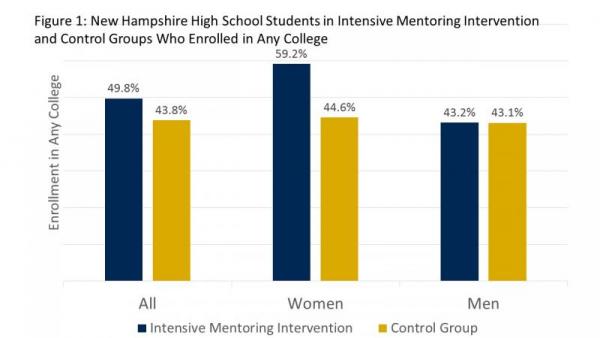College Mentoring Supports College Enrollment and Persistence
By Scott Carrell, UC Davis and Bruce Sacerdote, Dartmouth College
Among OECD countries, the United States has fallen from 1st (in 1990) to 9th (in 2016) in terms of the percentage of working age individuals with a bachelor’s degree.[1] This makes interventions that promote college attendance in the U.S. a top policy priority. The benefits of a college education are widely known. People with some college or more have consistently higher rates of labor market participation and lower levels of unemployment than those without any college.[2] Among the employed, those with a college degree have lifetime average earnings that are 43 percent higher for men and 51 percent higher for women than those with only a high school diploma.[3] In a recent study, we compared different types of brief interventions aimed at increasing college enrollment with a more intensive mentoring intervention among high school seniors. We find that more intensive mentoring is effective in supporting students who lack the assistance often provided by parents or college counselors.
Key Facts
- Evidence shows that brief interventions such as text messages or email reminders can increase college enrollment rates for some students.
- Our findings show that only a more intensive mentoring intervention increased college enrollment among a general population of high school seniors.
- The intensive mentoring intervention was especially effective for women and for students who had less support in navigating the college application process.
Raising college enrollment and graduation rates has become a top priority for poverty and education policy in the United States. In 2016, 69.7 percent of 2016 high school graduates were enrolled in colleges or universities,[4] however, just 21 percent of Americans age 25 and over had completed a bachelor’s degree.[5] A variety of interventions have been developed that aim to promote college readiness, most of which are aimed at students in middle school. However, researchers have recently begun to ask whether conducting interventions at later ages is more beneficial and whether brief or more intensive interventions are more effective.
Brief Educational Interventions Support College Planning and Enrollment
Leading theories about why students do not apply to and enroll in college include lack of prior planning, procrastination, lack of organizational skills, and lack of support. Interventions aimed at promoting college readiness are often carried out with students well before high school, in order to support preparatory course work. For older students on the verge of making a decision about whether to apply to college, brief interventions including email reminders and texting have been used. One high profile study showed that brief, low-cost information interventions can increase college enrollment by as much as five percentage points for high-achieving, low-income students. [6]
In our study, we wanted to find out whether interventions at older ages are effective among a broad group of high school students and whether there is a difference between brief informational interventions and interventions that are more intensive. Our research compares brief interventions with an intensive student mentoring intervention among high school seniors in New Hampshire from 2012-14. Based on a list of qualified students provided by school guidance counselors, we randomly assigned students to groups receiving different interventions and a control group as follows:
- Group 1 received an intensive mentoring program that provided one-on-one mentoring, payment of application and College Board fees and a $100 cash bonus upon completing the application process.
- Group 2 received a cash bonus upon completing the application process (no mentoring).
- Group 3 received information from colleges and encouragement to submit transcripts.
- Group 4 received no mentoring, cash incentives or informational support (control group).
We also collected demographic data and surveyed the students during their first two years after high-school graduation. We used multiple regression analysis to calculate the effect of receiving the intervention on the outcomes of enrollment at any college and college persistence (continuing three or more semesters).

Mentoring Support Interventions May be More Effective than Brief Interventions
Our results showed that only the intensive mentoring intervention was effective; it led to a statistically significant increase in college enrollment of six percentage points.[7] Students who received information and transcript or cash bonus interventions, without the mentoring, were no more likely to enroll in college than the control group.
A closer look at our results shows that success of the mentoring intervention was driven almost entirely by women, for whom college enrollment increased by 14.6 percentage points compared to the control group. The program was also more effective for students who were less prepared and had not taken the SAT or did not have parent or counselor support during their application process. The intensive mentoring intervention increased college enrollment for these students by 10.3 percentage points, compared to the control group. In terms of college persistence, the students that participated in the intensive mentoring intervention that enrolled in college were as likely to continue in college as students in the control group.
Mentoring Support May Act as a Substitute for the Support of Parents and Teachers
Our results show the benefits of in-person mentoring support relative to less intensive, brief interventions. To learn more about why mentoring works for certain students we looked at the relationship between the intervention received and students’ stated level of need for help navigating the college application process. We also looked at personality and demographic characteristics.
We found no evidence that the program worked better or worse for students based on personality characteristics or for reasons related to demographic differences. However, the mentoring intervention did seem to be particularly effective in schools with limited resources to support students in preparing for college. We concluded that mentoring works in our study as a substitute for the potentially scarce resource of parental or school-based help in navigating the college application process. Given the benefits of intensive interventions such as mentoring, we need to find cost-effective ways to provide guidance and support to students who need it.
Scott Carrell is a Professor of Economics at UC Davis.
Bruce Sacerdote is a Professor of Economics at Dartmouth College.
References
[1] Organization for Economic Cooperation and Development. 2017. “Education at a Glance”.
[2] Bureau of Labor Statistics. 2018. “Employment Status of the Civilian Population 25 Years and Over by Educational Attainment.”
[3] Tamborini, Christopher R. et al. 2016. “Education and Lifetime Earnings in the United States.” Demography.
[4] Bureau of Labor Statistics. 2017. “College Enrollment and Work Activity of 2016 High School Graduates”.
[5] U.S. Census Bureau. Current Population Survey. 2017. “Educational Attainment of the Population 18 Years and Over, by Age, Sex, Race, and Hispanic Origin: 2017. Annual Social and Economic Supplement.”
[6] Hoxby, Caroline and Turner, Sarah. 2013. “Expanding College Opportunities for High-Achieving-Low Income Students.” Stanford Institute for Economic Policy Research.
[7] Carrell, Scott and Sacerdote, Bruce. 2017. “Why Do College-Going Interventions Work?” American Economic Journal: Applied Economics.
#povertyresearch









